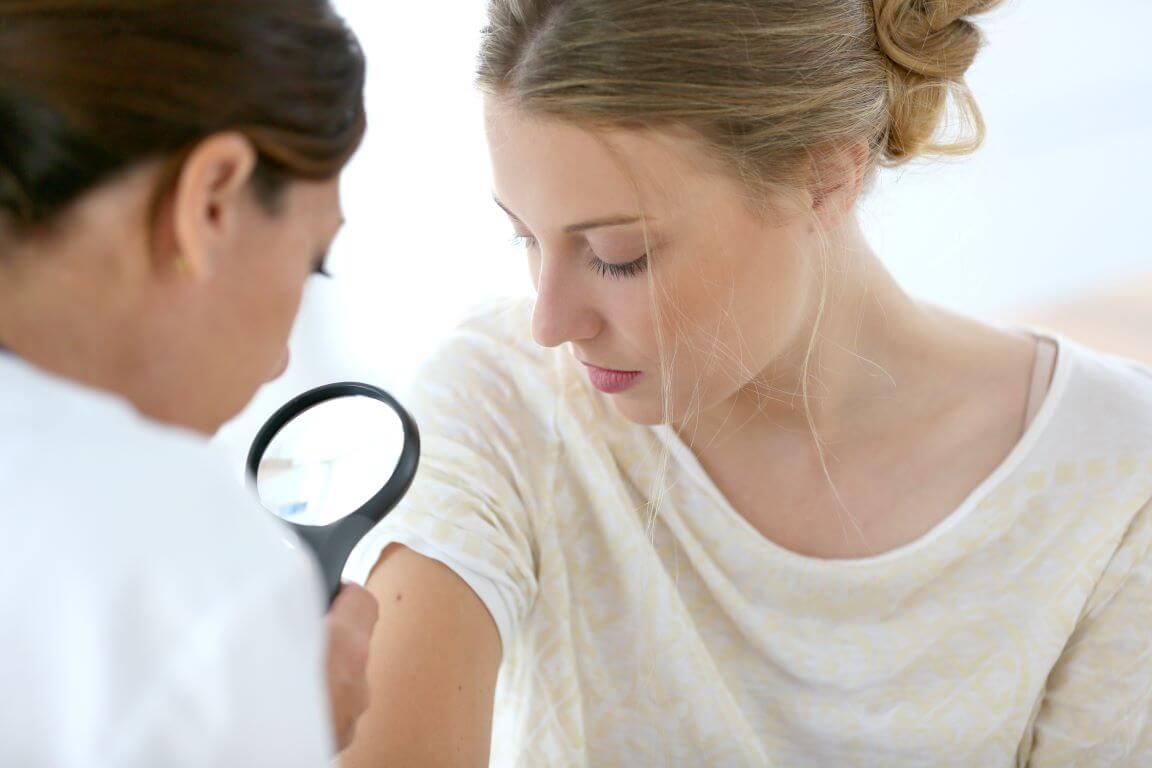New, different, or changing lesions are what most people think about when they hear the words, ‘skin cancer,’ but these are only the beginning when it comes to skin cancer symptoms. According to Dr. Drew Reese of U.S. Dermatology Partners in Goodyear, Arizona, “If you notice any changes or irregularities in the appearance or texture of the skin, you should have it looked at by a professional. Most people know that changing or irregular skin lesions indicate skin cancer, but every type of skin cancer has its own symptoms. Additionally, individuals may experience unique symptoms related to how their bodies respond to the cancer cells.” In this blog, Dr. Reese talks through the top six UNCOMMON signs of skin cancer.
Changes in Fingernails as a Sign of Skin Cancer
When looking for skin cancer symptoms, the nails are often overlooked. Dr. Reese says, “Symptoms of many forms of skin cancer can develop on the fingernails and toenails, but they are often overlooked because they’re not as easy to spot. Knowing what to look for can help people identify skin cancer symptoms that impact the nails and bring them to the attention of their dermatologist. Two of the most common types of skin cancer that present within the nails are squamous cell carcinoma and melanoma.” Some common signs of skin cancer in toenails and fingernails include:
- Dark bands or streaks beneath the nails.
- Skin around the nail that is darker than skin in other areas.
- Splitting nails, especially down the middle.
- Bumps beneath the nail or on the skin around the nail.
- Nail lifting or loose from nail beds.
- Nonhealing wound around nails
Pimple-Like Growths and Their Connection to Skin Cancer
Pimples are common skin health concerns that develop when pores become clogged with oil, dirt, bacteria, and other matter. In some cases, skin cancer may appear visually similar to a pimple. Pimples come in many shapes and sizes. They may be small bumps with white heads or black heads, or they can look like smooth lumps under the skin when blemishes form beneath the skin’s surface. Skin cancer often looks more like a smooth, shiny bump. Pimples tend to feel soft and moveable beneath the skin. Skin cancer is usually firm. If you have a pimple-like spot that doesn’t heal or begin to clear up within two weeks, you should contact your dermatologist.
The Importance of Regular Eye Exams in Detecting Skin Cancer
According to Dr. Reese, “Those who have poor vision usually receive eye exams regularly, and they may be surprised to hear that this can be an important element in receiving an early skin cancer diagnosis. Anyone can benefit from eye exams to help them spot potential signs of skin cancer in the area around the eyes. Additionally, there is a form of melanoma that develops within the eye itself. Symptoms of ocular (eye) melanoma include seeing flashes, blurred vision, loss of peripheral vision, dark spots in the iris, and change in pupil shape.” Any growths around the eye that are noticed during the eye exam can be referred to a dermatologist for evaluation.
The Uncommon Sign of a Mole Losing Color
When moles become darker, or there are multiple colors within a single mole, most people recognize this as a common warning sign of skin cancer. A much less common change in mole color that can also indicate skin cancer is a mole that becomes lighter in color. This symptom of melanoma can be more difficult to spot. In fact, lightening moles are often overlooked in self-exams, so it’s important to carefully examine skin each month and note all changes, including lightening moles.
Skin Cancer Bumps: A Closer Look
Almost all types of skin cancer cause lumps or bumps to form on the skin. Skin cancer bumps differ based on the types of cancer, which include:
- Basal cell carcinoma usually looks like a skin-colored, pink, or red raised bump. Blood vessels are often visible beneath the skin. In some cases, the bump is pearly and smooth, but some have indentations in the center or is simply a non-healing spot.
- Squamous cell carcinoma can also form bumps. Alternatively, this type of skin cancer can cause thickened patches of skin or areas that feel rough or flaky. Again, a non-healing wound can be this form of skin cancer.
- Melanoma typically appears as asymmetrical bumps or flat brown spots with uneven edges, irregular shapes, and multiple colors. The melanoma spot can change or grow rapidly.
- Merkel cell carcinoma – This rare type of cancer creates a painless bump that is often the same color as the skin. It can also cause red-blue lumps that protrude from the skin. These bumps typically develop on skin that’s exposed to sunlight.
Chapped Lips and Skin Cancer: What You Need to Know
Chronically chapped lips are a warning sign of a common pre-cancerous condition called actinic cheilitis, resulting from chronic sun damage. This condition causes chronic or prolonged lip dryness and cracking. It may impact the top and bottom lip, but it’s most common on the bottom lip. Left untreated, actinic cheilitis can develop into squamous cell carcinoma. Without proper treatment, squamous cell carcinoma may metastasize and spread to connected and unconnected areas. If a dermatologist determines that your chapped lips aren’t caused by skin cancer or precancerous skin conditions, there are some steps you can take to repair them. First, stay hydrated by drinking plenty of water. The more hydrated you are on the inside, the more hydrated your skin will be. You should also apply moisturizing lip balm several times a day, especially right before going to sleep. A great option is the Revision Skincare YouthFull Lip Replenisher. This product offers soothing moisture, protects skin from sun and environmental damage, and works to reverse the signs of aging like fine lines.
Reduce Skin Cancer Risks with Regular Self-Exams
Even if you don’t remember every symptom of skin cancer, you can keep an eye on your skin and look for signs of concern. According to Dr. Reese, “If you perform regular skin cancer self-exams, you’ll be more likely to notice right away if there are any changes in your skin. As soon as you notice changes, you can have a dermatologist examine your skin to determine if it’s skin cancer or another skin health concern. This increases the ability to diagnose skin cancer in earlier stages.”
Schedule an Annual Skin Cancer Exam Today
Most people think they know what skin cancer looks like, but it’s important to spread awareness of the less common symptoms of skin cancer. We hope you’ll share our blog with your loved ones to spread the word about these less common symptoms of skin cancer. If you’re concerned about skin cancer, you should reach out to schedule an annual skin cancer exam with a trusted professional at U.S. Dermatology Partners. Working with our local dermatology offices is easy. You simply complete our online scheduling request form, and we’ll reach out to take care of all the details.
Find a location near me
or


